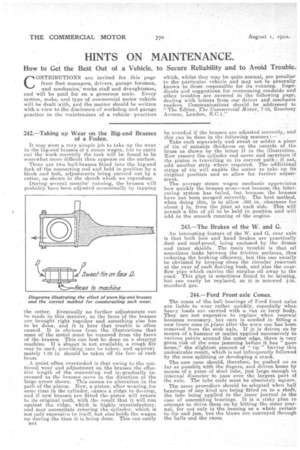HINTS ON MAINTENANCE.
Page 28

If you've noticed an error in this article please click here to report it so we can fix it.
How to Get the Best Out of a Vehicle, to Secure Reliability and to Avoid Trouble.
CONTRIBUTIONS are invited for this page from fleet managers, drivers, garage foremen, and mechanics,' works staff and draughtsmen, and will be paid for on a generous scale. Every system, make, and type of commercial motor vehicle will be dealt with, and the matter should he written with a view to the disclosure of workshop and garage practice in the maintenance of a vehicle—practices which, whilst they may be quitonormal, arc peculiar to the particular vehicle and may not be generally known to those responsible for its running. Expedients and suggestions for overcoming roadside and other troubles are covered in the following page, dealing with letters from our driver and mechanic readers. Communications should be addressed to "The Editor, The Commercial Motor, 7-15, Rosebery Avenue, London, E.C.1."
242.—Taking up Wear on the Big-end Brasses of a Foden.
It may seem a very simple job to take up the wear_ in the big-end brasses of a steam wagon, but to carry out the work correttly the task will be found to be somewhat more difficult than appears on the surface. There are two half-brasses fitted into the big-end fork of the connecting rod and held in position by a block and bolt, adjustments being carried out by a cotter, as shown in the sketch which we reproduce. During several months' running, the brasses will probably have been adjusted occasionally by tapping the cotter. Eventually no further adjustments can be madoin this manner, as the faces of the brasses are .brought right together and something else has to be done, and it is here that trouble is often caused. It is obvious from the illustrations that some or the metal must be removed from the faces of the brasSes. This can best be done on a shaping machine. If a shaper is not available, a rough file may be used, providing care be taken, and approximately 1-32 in. should be taken off the face of each brass.
A point often overlooked is that owing to the continual wear and adjustment on the brasses the effective length of the connecting rod is gradually increased as the brasses move in the direction of the large arrow shown. This causes an alteration in the path of the piston. Now, a piston, after wearing for some time in the cylinder, causes a ridge to develop, and if new brasses are fitted the piston will return to its original path, with the result that it will run against the ridge, which is highly unsatisfactory, and may necessitate reboring the cylinder, which is not only expensive in itself, but also holds the wagon tip during the time it is being done. This can easily
B44 be avoided if the brasses are adjusted correctly, and this can be done in the following manner :—
Take each separately and sweat or solder a piece of tin of suitable thickness on the outside of the brass as shown by the letter D in the illustration. Now remove the cylinder end cover and ascertain if the piston is travelling in its correct path ; if not, add another strip where required. The additional strip, of tin will enable the cotter to take up its drigmal position and so allow for further adjustment. The average steam wagon mechanic; appreciates how quickly the brasses seize—not because the lubricating system has failed, but because the brasses have not been scraped correctly. The best method, when doing this, is to allow .003 in.clearance for about in. from the joint at each side. This will permit a film of oil to be held in position and will add to the smooth running of the engine.
243.—The Brakes of the W. and G.
An interesting feature of the W. and G. rear axle is that both foot and hand brakes are practically dust and mud-proof, being enclosed by the drums and inner shields. The main trouble is that oil sometimes leaks between the friction surfaces, thus reducing the braking efficiency, but this can usually be obviated by keeping clean the circular reservoir at the rear of each floating bush, and also the overflow pipe which carries the surplus oil away to the road. This pipe is sometimes found to be missing, but can easily be replaced, as it is screwed i-in. standard gas.
, 244.—Ford Front-axle Cones.
The cones of the ball bearings of Ford front axles are liable to wear rather quickly, especially when heavy loads are carried with a van or lorry body. They are not expensive to replace when renewal becomes necessary, but care is needed in fitting a new inner cone in place after the worn one has been removed from the stub axle. If it is driven on by means of a hammer or mallet applied successively to various points around the outer edge, there is very great risk of the cone jamming before it has "gone home," the slightest amount of "tip " having this undesirable result, which is not infrequently followed by the cone splitting or developing a crack. The new cone should, therefore, be pushed on as far as possible with the fingers, and driven home by means of a piece of steel tube, just large enough in internal diameter to pass over the largest part of the axle. The tube ends must be absolutely square. The same procedure should be adopted when ball bearings of any kind are being fitted on to a shaft, the tube being applied to the inner journal in the case of assembling bearings. It is a risky plan to attempt to drive them on by hitting the outer journal, for not only is the bearing as a whole certain to tip and jam, but the blows are conveyed through the balls and the races.






























